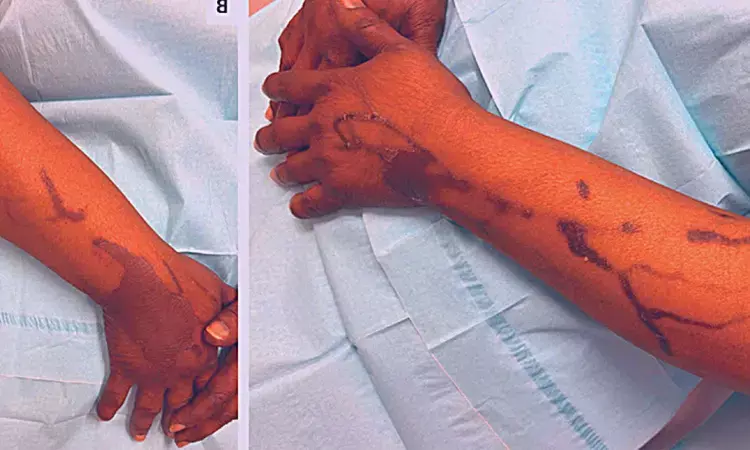- Home
- Medical news & Guidelines
- Anesthesiology
- Cardiology and CTVS
- Critical Care
- Dentistry
- Dermatology
- Diabetes and Endocrinology
- ENT
- Gastroenterology
- Medicine
- Nephrology
- Neurology
- Obstretics-Gynaecology
- Oncology
- Ophthalmology
- Orthopaedics
- Pediatrics-Neonatology
- Psychiatry
- Pulmonology
- Radiology
- Surgery
- Urology
- Laboratory Medicine
- Diet
- Nursing
- Paramedical
- Physiotherapy
- Health news
- Fact Check
- Bone Health Fact Check
- Brain Health Fact Check
- Cancer Related Fact Check
- Child Care Fact Check
- Dental and oral health fact check
- Diabetes and metabolic health fact check
- Diet and Nutrition Fact Check
- Eye and ENT Care Fact Check
- Fitness fact check
- Gut health fact check
- Heart health fact check
- Kidney health fact check
- Medical education fact check
- Men's health fact check
- Respiratory fact check
- Skin and hair care fact check
- Vaccine and Immunization fact check
- Women's health fact check
- AYUSH
- State News
- Andaman and Nicobar Islands
- Andhra Pradesh
- Arunachal Pradesh
- Assam
- Bihar
- Chandigarh
- Chattisgarh
- Dadra and Nagar Haveli
- Daman and Diu
- Delhi
- Goa
- Gujarat
- Haryana
- Himachal Pradesh
- Jammu & Kashmir
- Jharkhand
- Karnataka
- Kerala
- Ladakh
- Lakshadweep
- Madhya Pradesh
- Maharashtra
- Manipur
- Meghalaya
- Mizoram
- Nagaland
- Odisha
- Puducherry
- Punjab
- Rajasthan
- Sikkim
- Tamil Nadu
- Telangana
- Tripura
- Uttar Pradesh
- Uttrakhand
- West Bengal
- Medical Education
- Industry
Rare case of Serpentine Supravenous Hyperpigmentation reported in NEJM

Serpentine supravenous hyperpigmentation (SSH) was the term coined by Hrushesky in 1976 to describe increased pigmentation of the skin immediately overlying the venous network.The other names by which it has been described are "persistent supravenous erythematous eruption," "persistent serpentine supravenous hyperpigmented eruption," and "persistent SSH." It is a benign and self-limiting condition.
Serpentine supravenous hyperpigmentation is a peculiar cutaneous eruption that follows the path of vein after intravenous injection of the chemotherapeutic agent. The lesions gradually resolve spontaneously if administration of the offending agent is stopped through the affected limb. Usually Drugs such as 5‐fluorouracil, docetaxel, vinorelbine, hydroxychloroquine, fotemustine, and minocycline are implicated.
A 58-year-old woman with a history of metastatic uterine leiomyosarcoma presented to the dermatology clinic with a 1-month history of a nonpruritic rash on her arms. Six weeks before presentation, she had started palliative chemotherapy with gemcitabine and docetaxel, which had been administered through peripheral intravenous catheters. On examination, hyperpigmented plaques were observed on the dorsa of both hands at the sites of previous intravenous access. The darkened skin extended up the arms in a linear pattern along the network of superficial veins (Panels A and B). The skin lesions were slightly palpable but were not tender.
A diagnosis of docetaxel-associated serpentine supravenous hyperpigmentation was made. Serpentine supravenous hyperpigmentation is a cutaneous side effect of several intravenous chemotherapy agents, including docetaxel, vinorelbine, and-most commonly-fluorouracil. The mechanism of skin hyperpigmentation remains unclear, but the reaction is benign; the underlying veins remain patent. The reaction can be avoided with the use of a central venous catheter for drug infusion. In this patient, a central venous catheter was placed for subsequent administration of chemotherapy. At a follow-up visit 2 months later, the rash had abated.
Reference:
December 22, 2022 N Engl J Med 2022; 387:e67 DOI: 10.1056/NEJMicm2207158Dr Kamal Kant Kohli-MBBS, DTCD- a chest specialist with more than 30 years of practice and a flair for writing clinical articles, Dr Kamal Kant Kohli joined Medical Dialogues as a Chief Editor of Medical News. Besides writing articles, as an editor, he proofreads and verifies all the medical content published on Medical Dialogues including those coming from journals, studies,medical conferences,guidelines etc. Email: drkohli@medicaldialogues.in. Contact no. 011-43720751


